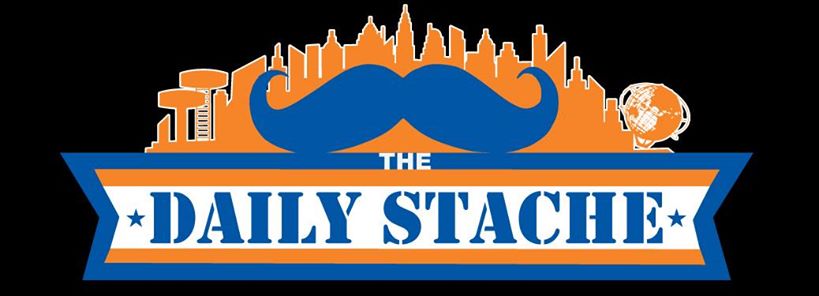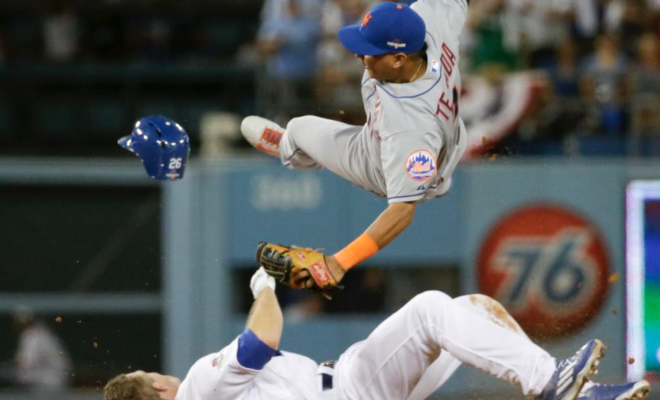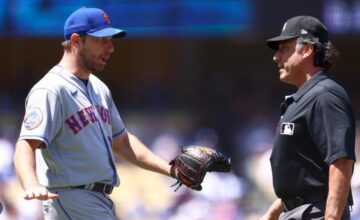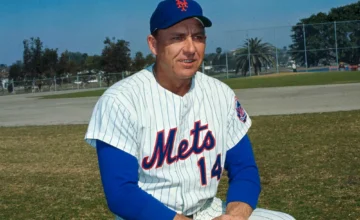When Dodgers 2B Chase Utley slid into Mets SS Ruben Tejada in Game 2 of the NLDS, it changed the complexion of the game and the series. Utley slid late and out of the base path, breaking Tejada’s leg and stopping the double play. It was a dirty slide, and it affected the outcome of the game: if the play had been correctly called as interference, the double play would have counted and the Mets would have been likely to win the game. As it was, the Dodgers won Game 2 and prolonged the series.
The Mets eventually sent the Dodgers home in a do-or-die Game 5 in Dodger Stadium, but that hasn’t ended the debate. Utley’s slide earned him a two-game suspension (he’s currently appealing and was allowed to play in the interim), and plenty of observers thought it was about time that his play caught up with him. David Wright made comments about Utley’s reckless slides as early as 2010, and Mets fans are quick to point out Utley’s history of dangerous play.
Is this just an emotional playoff reaction, or does Utley really have a history of dirty play? Few would question that the latest slide was dirty, but asserting a pattern of behavior is a different thing. Let’s go to the tape.
September 24, 2010
Philadelphia Phillies vs. New York Mets
The past slide that players and observers pointed to most in the aftermath of the NLDS incident was this 2010 moment. That’s because the victim is a familiar face: it’s Ruben Tejada, five years ago, getting the same treatment.
This slide didn’t actually break up the double play, but it wasn’t for lack of trying. Once again, Utley slides late. He hits the dirt before he hits Tejada, but only barely. He is in the base path, for what it’s worth, but this slide is very late.
Verdict: Dirty
October 2, 2011
Philadelphia Phillies vs. St. Louis Cardinals, NLDS Game 2
Four years ago, Chase Utley was in the NLDS with the Phillies. Just like this year, he made a questionable slide in Game 2 of the series. Just like this year, he successfully broke up the double play. Fortunately for the Cardinals’ Ryan Theriot, there was no broken leg this time.
Here again, we see that Utley is sliding very, very late. Like 2010, he’s in the base path, which makes this one a little less egregious than the slide that took out Tejada. Still, the lateness of the slide makes this one dirty.
Verdict: Dirty
September 4, 2015
Los Angeles Dodgers vs. San Diego Padres
Here’s an interesting slide. This is kind of out of the ordinary for Utley: here, he hits the dirt a little earlier (less dirty) but is way, way out of the base path (more dirty).
This should clearly have been called interference, because Utley is nowhere near second base. That said: it’s hard to say that this slide is dangerous to Padres SS Jedd Gyorko. Current MLB rules and practices do condone breaking up the double play – nobody is denying that – so Utley has to go above and beyond to make this play illegal or dirty. It’s one, but not the other.
Verdict: Illegal, but not dirty
Conclusion
It’s probably fair to say that Utley has a history of dirty slides. He doesn’t always leave the base path like he did to take out Tejada, but he consistently slides very late and past the bag.
Does Chase Utley intend to hurt anyone with these late slides? That’s very doubtful. But the reality is that his reckless play puts shortstops in danger, and his refusal to follow the rules implemented for their safety makes him a dirty player.




